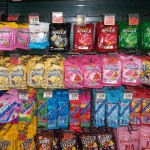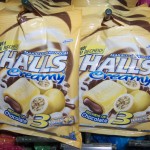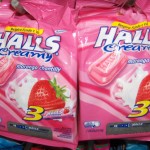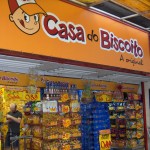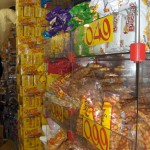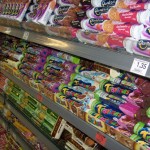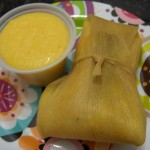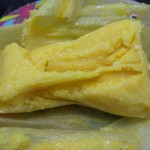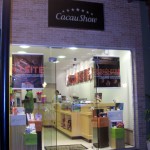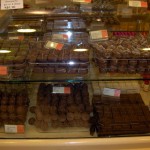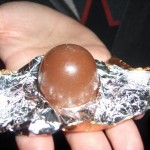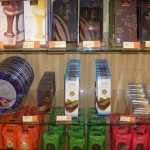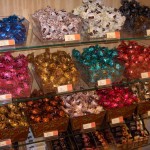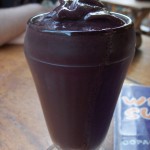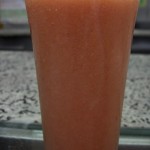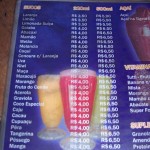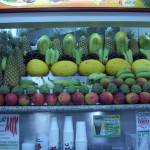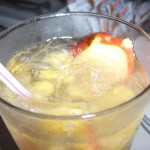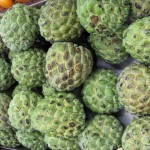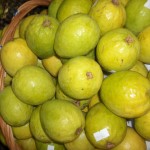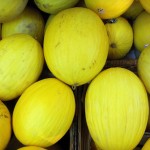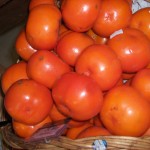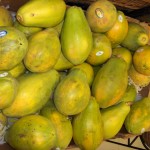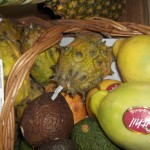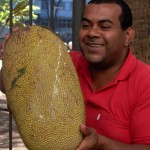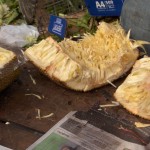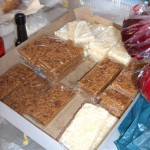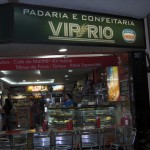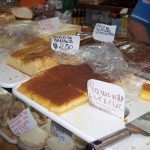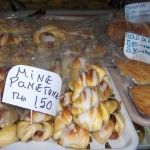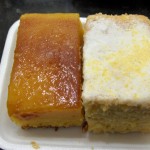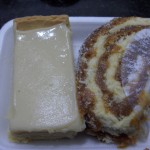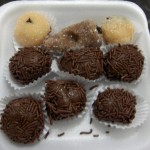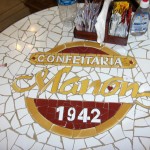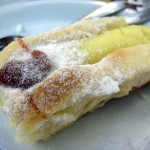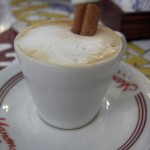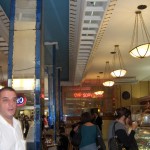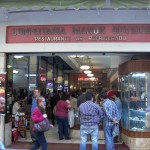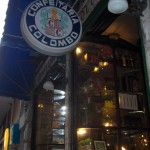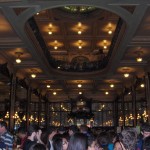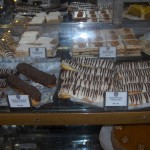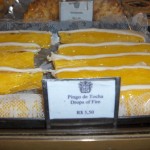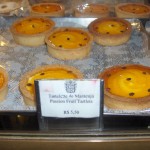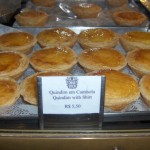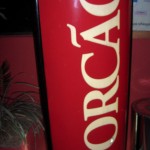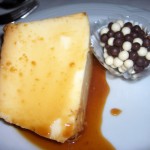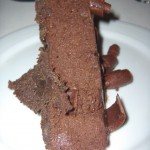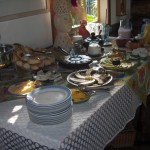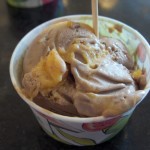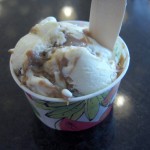Brazil
Brazil: The Ugly (or the kinda weird)
Brazil’s dessert landscape has a few more curiosities:
1. Halls (yes, the company that makes your cough drops) are candy. This realization dawned on me after seeing everyone from street vendors to grocery stores to juice bars hawking them alongside other prepackaged sweets. At first I thought, “Wow, Brazilians must have 24/7 sore throats or something– ick.” But then I peered closely and read some of the flavor names, such as “Halls Creamy: Tropical Passion Fruit with Chocolate Center.” It’s so weird because they still sell the menthol-eucalyptus-cherry-lyptus-honey-horror flavors right alongside the sweet ones, but they just have a higher “Halls Power” rating of, like, 5 out of 5 for “extra forte-lyptus,” rather than a 1 out of 5 for “Halls Creamy: Strawberry Cream.” Do you think Brazilian kids beg for them when they’re <cough> sick like my brothers and I used to beg for completely ineffective cherry Ludens?
2. Just like the Brits, Brazilians just loooove biscuits. I would say that this love is similar to Americans and their cookies, but it’s different: there are several chain stores that are literally devoted to biscuits, Casa do Biscoito being one of them. Inside these yellow-hued wonderlands, you’ll find enormous, heaping towers of biscuits in every kind of packaging imaginable, from rolls to boxes to sacks. It’s a feast for the eyes, if not necessary the palate. Are wafer-based items included? You betcha. What would the rest of the world do without their wafers?  Despite looking down my nose at them as a young dessertatarian, because I thought they were too cheap and light to be proper sweets, I have now come to appreciate their subtle charms and pleasant crunch. The wafers I tried from the Casa, however, sent my development back about a year, as I tried to go for the chocolate flavor, and, as already discussed in a previous post, found them to be totally unsatisfying. I also had to close my eyes during each bite for fear that some of the wafer shards would come flying up and blind me. On the other hand, they were so dry that the billions of crumbs that ended up in my lap just blew right off when I got up. I hope I didn’t blind anyone around me, though.
3. Do you like vaguely sweet corn pudding? Because the Brazilians do. It’s a typical street vendor food that you might think is the aforementioned quindim, but it’s more yellow-yellow what with the corn, rather than eggy golden-yellow. It’s called curau and comes in a dry-ish form wrapped in a corn husk, tamale-style, or in a cup for the wetter version.  They both taste… fine… just fine.
Brazil: The Bad
I know that I’m jeopardizing Brazil’s status as one of the world’s great dessert oases and will therefore lose some of you readers here, but it simply must be said: there is almost no fine chocolate culture in that country. I confirmed this with the American owner of our bed and breakfast in Paraty (the fabulous Pousada Guaraná), who had to go all the way to São Paulo for a decent-enough cocoa to make his chocolate breakfast cake. He said there just isn’t the demand for fine chocolate as there is in New York, for example, where even the lowliest of bodegas at least stocks Lindt.Â
As far as I could tell, if you’re on the hunt for chocolate, you have two choices: Garoto or Cacau Show. Garoto is your average, run-of-the-mill, store-bought chocolate that comes in all manner of Euro-style bon-bons and bars, sort of like Cadbury’s in the U.K. or Hershey’s in the U.S. But I tell you this: Garoto is not even as good as Hershey’s. It’s a little gritty, totally waxy, and flavorless– like cheap Polish or Russian chocolate. Are you shocked that it’s now owned by Nestlé after being founded by a German-Brazilian in the 1920s? If you’re hankering for chocolate, eating some Garoto will be such a frustratingly bad experience, it’s probably not even worth it. You’ll moan and cry in despair and hope that at least there’s a Cacau Show store in town somewhere that you can hop a cab to. Cacau Show is the only “high-end” chocolate chain that I could find. It was actually founded by a 17 year old Brazilian kid in 1988 and is still wholly owned by the original company, which is a real feat in the monopolistic world of foodstuffs.  The chocolate is unevenly good. The bars and individual chocolates were a disappointment and lacked a rich cocoa flavor. The brightly-wrapped truffles, however, were actually quite good and come in flavors like coconut, chili pepper, and hazelnut. They were probably the only chocolate I had in Brazil that I enjoyed and filled that terrible void that I was beginning to feel very desperate about.
Brazil: The Good
Brazil provides the dessertatarian with one of her most basic needs: SUGAR.  I can’t help but use all screamin’ caps, because, like, seriously, Brazil has a lot of sugar– they even run their cars on it in the form of ethanol.  The heft of the typical Brazilian table sugar packet is considerably more than those in the US, too.  On my recent trip to fabulous Rio de Janeiro and the little colonial town of Paraty, I did indeed ingest a lot of sugar in a “when in Rome…” kind of way, of course.
Sucos (or juice) purveyors are plentiful in coastal towns like Rio and often have surfer dude names like “Winds” and “Beach Sucos.”  Here you can try all manner of wonderful juices, many of which are made with fruits you never even knew existed (if you’re from the Northern Hemisphere).  My favorite was the highly caffeinated and addictive açai/guarana mix, which is served in a tall ice cream sundae glass.  It’s not juice so much as a melty sorbet that is piled up about an inch over the top of the glass, and it somehow stays there without overflowing.  My first thought at this presentation was “I’ll never see the bottom of this glass,” but then after a few ravenous snorts, snarfs, and brain freezes, it would just… disappear.  It is so dark purple, it almost looks chocolatey and has a pleasantly gritty, rich texture, with the flavor of black currants.  A few others I tried were caju (or cashew fruit, has a putrid smell not unlike durian, but the flavor isn’t all bad and does grow on you when you begin to also taste something akin to pineapple); graviola (or soursop, smooth, creamy, similar to melon or pear in flavor and a favorite),acerola (acidic, berry-like, quite tart), melon (so light and sweet, another winner), guava, cupuaçu (acidic, similar to watery orange juice), and fruta do conde (or sugar-apple, tasty).  At night, sucos gave way to caipirinhas, which are fruity, sugary drinks made with cachaça (or fermented sugarcane alcohol).  The usual ones are lime-based, but I saw lots with passion fruit, mango, and even one with slices of cashew fruit, which has a creepily meat-like, um, flesh.
Coconut is also featured heavily in Brazilian desserts– good thing I love it, as it is one of those oddly polemical ingredients.  I wonder what happened to people in their early childhoods to make them hate the taste of coconut?  Did their first-grade teacher whack them with an Almond Joy bar, rather than a ruler, perhaps?  Probably the best coconut dessert is also the simplest: cocada (or coconut candy), which comes in white sugar and brown sugar varieties.  It’s also nicely shelf-stable, which would make it the perfect gift to bring home, if not for its brick-like weight.
Brazilian bakeries and sweets shops are wonderfully ubiquitous, from self-serve neighborhood joints offering homemade flans, puddings, and cakes, to the famous confeitarias of Manon and Columbo, where you can get French-style patisseries with a Brazilian flair.  One of the most popular items is the bright yellow quindim or quindão, which is a kind of puddingy custard flan thing made with tons of egg yolks (a Portuguese technique) and coconut. Quindim actually means “girlish charms” in a Bantu language, which was spoken by African slaves in Brazil in the 17th Century, so you can learn your triangle trade history while you eat. When it’s sobremesa (or dessert) time, here are some more of the heavenly words that your pocket translator (or fluent friend) will conjure for you: dulce de leche, ice cream, tapioca, lemon/lime (you’re never sure which, since they’re both oddly called limãos), fresh fruit sorbet, guava paste, and pastry cream.
You’ll be happy and unsurprised to know that the next posts are entitled “Brazil: The Bad” and “Brazil: The Ugly (or just kinda weird, actually).”
